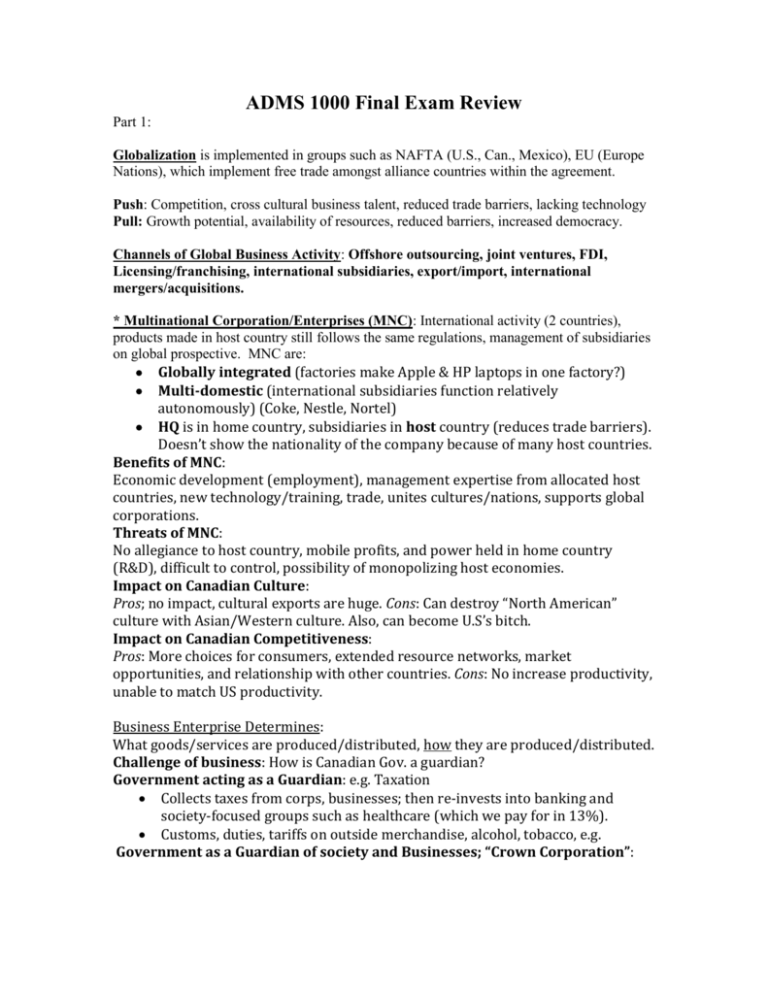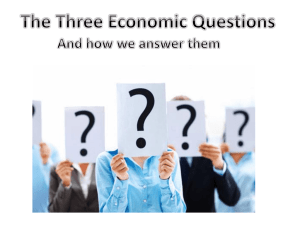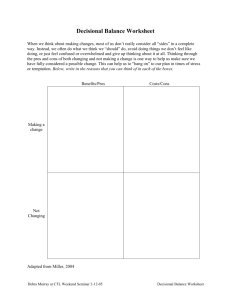adms_1000_final_exam_revi
advertisement

ADMS 1000 Final Exam Review Part 1: Globalization is implemented in groups such as NAFTA (U.S., Can., Mexico), EU (Europe Nations), which implement free trade amongst alliance countries within the agreement. Push: Competition, cross cultural business talent, reduced trade barriers, lacking technology Pull: Growth potential, availability of resources, reduced barriers, increased democracy. Channels of Global Business Activity: Offshore outsourcing, joint ventures, FDI, Licensing/franchising, international subsidiaries, export/import, international mergers/acquisitions. * Multinational Corporation/Enterprises (MNC): International activity (2 countries), products made in host country still follows the same regulations, management of subsidiaries on global prospective. MNC are: Globally integrated (factories make Apple & HP laptops in one factory?) Multi-domestic (international subsidiaries function relatively autonomously) (Coke, Nestle, Nortel) HQ is in home country, subsidiaries in host country (reduces trade barriers). Doesn’t show the nationality of the company because of many host countries. Benefits of MNC: Economic development (employment), management expertise from allocated host countries, new technology/training, trade, unites cultures/nations, supports global corporations. Threats of MNC: No allegiance to host country, mobile profits, and power held in home country (R&D), difficult to control, possibility of monopolizing host economies. Impact on Canadian Culture: Pros; no impact, cultural exports are huge. Cons: Can destroy “North American” culture with Asian/Western culture. Also, can become U.S’s bitch. Impact on Canadian Competitiveness: Pros: More choices for consumers, extended resource networks, market opportunities, and relationship with other countries. Cons: No increase productivity, unable to match US productivity. Business Enterprise Determines: What goods/services are produced/distributed, how they are produced/distributed. Challenge of business: How is Canadian Gov. a guardian? Government acting as a Guardian: e.g. Taxation Collects taxes from corps, businesses; then re-invests into banking and society-focused groups such as healthcare (which we pay for in 13%). Customs, duties, tariffs on outside merchandise, alcohol, tobacco, e.g. Government as a Guardian of society and Businesses; “Crown Corporation”: Natural monopolies; electricity, Canada Post. Public interest: Petro Canada. Protects vital industries like the Canadian National Railway, Air Canada, LCBO is a crown corporation, but CC’s are lessening. Role of Government in business regulation: Government imposes to modify economic behavior in private sectors (energy, health safety, labor etc.) Public interest (Protects consumers with pricing, foreign ownership, FDA). Regulating Market Practices: Federal/provincial regulation: Legal constraints, fair efficient/competitive marketplace e.g., nutrition guides, ingredients. Competition bureau, Health Canada, Environment Canada. Perfect Competition: Self-interests w/open economic system (consumer satisfaction-companies). Market controls prices e.g., Pepsi/Coke. Imperfect Competition: Control their prices e.g., apple. Guards consumers: FDA, health administrative acts, nutrition labels. Gov. guardian private businesses: Helps if needed, best interest of the country, people, and if they need it through incentives, and bailouts. Pros and Cons of Subsides (to prop up businesses for further development): Pros: helps to protect/provide Canadian jobs, ensures legit goods/services. Cons: Businesses receive handouts because of value to society, fair competition doesn’t play a role for global (Canada being a host country at times) businesses. My pocket. Global issues: Maintaining domestic labor force, protection against unfair trade, subsidizing global business activity, encouraging FDI, keeping a trade balance, helps young industries. Deregulating the Gov. because lack of Guardianship. Deregulation improves productivity and businesses gain profit because of less Gov. power. *Privatization: Removing Gov. involvement. Pros: More competition, more efficiency, evolution of business sector, money from sell-offs. Cons: Shareholders can be stakeholders, community stakeholders, employee stakeholders, need to regulate. Analyzing External Environment: You must change with your environment. International trade encouraged free trade agreement, but raised protectionism (Government being a guardian). Logic of trade: I trade you corn for an apple because you cannot produce corn, nor I apple. GATT 180 countries agreed to reduce tariffs, WTO took over from GATT to manage trade agreements. IMF is short-term aid while World Bank is long-term loans. Tariffs: Tax placed on goods entering the country. Quota: Limits the goods entering the country. Regional Economic Integration: Free Trade Areas remove sub’s/quotas for member countries but autonomy (self-governing) in selecting trade agreements with non-members. Customs Union is FTA + less freedom about interacting with non-members. Common Market is CU + a free flow of labor and capital across borders (NAFTA). Economic Union is CM + co-ordination of economic policies including high levels of integration. Trading Blocks such as European union (Canada’s most influential trading partners). Asia Pacific Economic Community (Australia, Canada, USA, etc.). ASEAN (Brunei, Cambodia, Indonesia, etc.) NAFTA: Effects business, consumers, employment, trade, and culture. Pros: Increased trade between Canada, US, and Mexico boosting economies. Cons: Competition is too strong (forces bankruptcy, job losses, cheaper productivity and cheaper labor OUTSIDE NAFTA countries); need newer, more developed countries into the NAFTA agreement. Part 2: Five Forces Analysis: 1. Threat of New Entrants (New or diversifying) Barriers of Entry; Economies of scale, capital requirements, switching costs, access to distribution channels, cost disadvantages unrelated to scale, intellectual property (patents, trademarks, trade secrets). 2. Bargaining power of Suppliers Importance of supplier factories, company has more suppliers? 3. Bargaining power of Buyers Switching costs, is the product important to buyers, influential buyers? 4. Threats of Substitutes Coke Vitamin Water (Healthy), Car Train (Gas), Movies Netflix. (Convenience) 5. Rivalry Amongst Existing Firms Does your Rival dictate your product or prices? (High fixed costs, specialized assets and sunk costs, escalating commitment, social pressure). Coke Pepsi, Air Canada American Airlines, Apple (fixed costs) Dell/HP laptops. V(valuable)R(Rarity)I(Hard to Imitate)O(Organized to exploit, all VRI in place make O) Use VRIO model to figure out the SWOT analysis for any company. S(Strength)W(Weakness)O(Opportunity to advance or diversify)T(ANY Threats) Business-Level Strategies; How to compete in a given market (Porter): 1. Cost Leadership Economies of scale, learning curve economies, low-cost access to factors of production. Advantages; Higher margins, adaptation to any of the 5 force-analysis. 2. Product Differentiation Features and quality, product functions, location, mix and building, links with other firms products, customer service. Advantages; Product higher priced/value, ability to withstand pressures. 3. Focus on a specific market or Product by EITHER NOT BOTH Focused Low Cost OR Differentiation Corporate-Level Strategy: 1. IntrA-Firm Dynamics Focuses on Growth and Managerial self-interest and agency problems. 2. IntER-Firm Dynamics Market power, intense competition, and imitation. Diversification Types: Get Jonathan to explain. 1. Related products and markets who generate synergies and economies of scope 2. Unrelated who combine and hold companies (EXPLAIN) 3. Vertical Integration; Backward/upstream = Supl. Forward/Downstream = Cust. How to Diversify: (4) 1. Internal Development Greater control, takes longer, requires major commitment to allocate resources and exposure to risks. 2. Mergers and Acquisitions Faster to diversify, difficulty in combining organizations for synergic economic scale/scopes. 3. Strategic Alliances (two or more firms working together to achieve common obj) Non-equity contractual agreements; Market or distribution agreements and joint R&D efforts. Equity alliances: Partial ownership. Joint ventures: 1 Firm + 1 Firm = 1 Firm. Quicker access than Internal Development and less risk than Mergers and Acquisitions. Shared returns may arise issues within the firm. 4. Implementing Strategies Get Jonathan to explain. Contingency Theory – no best way to organize a corporation. You must have all these: strategy, structure, management philosophy, technology, and general environmental trends. Mechanistic VS Organic, Functional VS Multi-Divisional Forces of Change: Society, Economy, Politics, Technology, Legal, Competition. Types of Change: (3) Developmental is when you improve current strategies. Transitional is when you replace existing structure and processes; mergers, new products. Transformational is when the future outcomes are uncertain but organization and employees embark upon a period of widespread change. Methods of Change: 1. Theory E (Focuses on formal structural and systematic change) Maximizes shareholder value, driven by highest authorities, bonuses/reengineering/downsizing are involved. -11,000 jobs, -locations, new HQ. 2. Theory O Get Jonathan to explain. (Focuses on human capacity and learning from change) Maximizes employee learning and performance, tries to get organization recognized, flatter structures/employee involvement/employee-union relation/skill-based pay system/no lay-offs/employees own stocks. Transformational Challenge: (just know general contents, no need to study) Understanding the forces of change, changed vision and implementation (best interest of company through visional and institutional change), cultural change (new country, or new cultures in current market, family-oriented organization), change through communication (straight-forwardness communication), reinforcing change (Change to those who do not accept it, but is stressed upon them). Change is a process, NOT an event. Learning organizations (Adapts to environment, learns from employees and stakeholders, contributes to learning of stakeholders. Single loop learning – You fix the problem. Double loop learning – You find the problem; fix it to prevent further issues. Paradigm – Beliefs or mental framework for understanding how the world works (values & priorities so change in paradigm shift means change in way we view the value-world. Bureaucracy (Gov./higher power makes decisions, not president), roles, and individual change: Institutional theory plays a role (rules and processes). Cognitive scripts: Helps people understand how to think and behave in society. Resist change: Fear of the unknown, habit, no need for change, social relationships, economic insecurity. Overcoming Resistance to Change: Communication & negotiation, coercion, shift paradigms/mental model, change cognitive scripts, employee involvement, training. Gladwell’s Theory of change as an epidemic (3 Rules) 1. Law of the few – Few people = Less power 2. Stickiness Factor – Stress a message = Sticks to people and acceptance occurs. 3. Power of Context – Where change happens and the people encourage change in small ways







